Click on images to enlarge
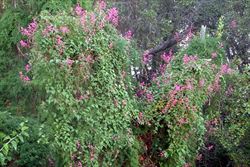
infestation showing climbing habit (Photo: Sheldon Navie)
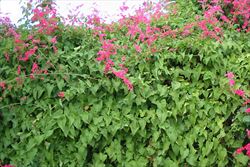
habit growing on a fence (Photo: Sheldon Navie)

scrambling habit (Photo: Sheldon Navie)

leaves with prominently wrinkled surfaces, parts of some tendrils may also be seen (Photo: Sheldon Navie)
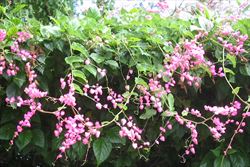
older flower clusters with tendrils at the tips of their branches (Photo: Sheldon Navie)
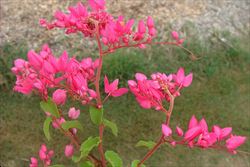
younger flower cluster (Photo: Sheldon Navie)
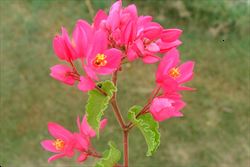
flowers and smaller upper leaves with wavy margins (Photo: Sheldon Navie)
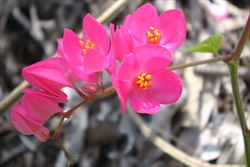
close-up of flowers and flower buds (Photo: Sheldon Navie)
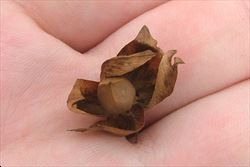
close-up of a mature fruit (Photo: Sheldon Navie)
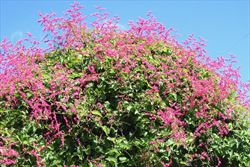
habit (Photo: Forest and Kim Starr, USGS)
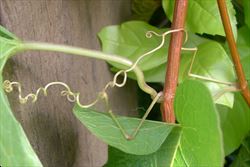
woody older stems and coiled tendrils in the leaf forks (Photo: Sheldon Navie)

close-up of heart-shaped leaf (Photo: Sheldon Navie)
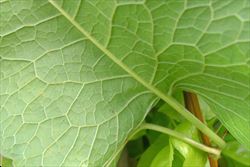
close-up of leaf underside (Photo: Sheldon Navie)
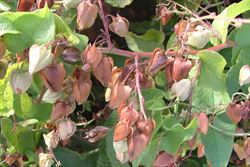
immature and mature fruit enclosed in old 'petals' (Photo: Sheldon Navie)
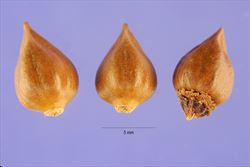
close-up of 'seeds' (Photo: Steve Hurst at USDA PLANTS Database)
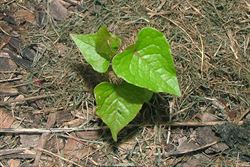
seedling (Photo: Sheldon Navie)
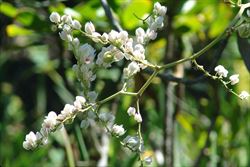
Antigonon leptopus 'Alba', a cultivar with white flowers (Photo: Forest and Kim Starr, USGS)
Scientific Name
Antigonon leptopus Hook. & Arn.
Family
Polygonaceae
Common Names
bride's tears, chain of love, chain-of-love, Confederate vine, coral bells, coral creeper, coral rose vine, coral vine, coralita, corallita, coralvine, hearts on a chain, Honolulu creeper, love vine, love-vine, Mexican creeper, Mexican love vine, Mexican rose, mountain coral vine, mountain rose, queen's jewels, queen's wreath, Sandwich Island creeper
Origin
Native to Mexico (possibly also western Guatemala).
Cultivation
This species is widely cultivated in northern and eastern Australia for its attractive bright pink flowers. A cultivar with white flowers (i.e. Antigonon leptopus 'Alba') is sometimes also seen in gardens, and a cultivar with dark red flowers (i.e. Antigonon leptopus 'Baja Red') is grown overseas.
Naturalised Distribution
Widely naturalised in the wetter parts of northern Australia (i.e. in the coastal districts of Queensland, in the northern parts of the Northern Territory and in the coastal districts of northern Western Australia). Also naturalised on Christmas Island.
Naturalised overseas in Africa, Asia, south-eastern USA (i.e. Texas, Louisiana, Mississippi, Alabama, Georgia, Florida and South Carolina), the Caribbean, La Réunion, East Timor, Papua New Guinea and on numerous Pacific islands (i.e. the Galápagos Islands, Fiji, French Polynesia, Guam, Nauru, Niue, New Caledonia, the Cook Islands, the Solomon Islands and Hawaii).
Habitat
A weed of waterways and riparian areas, monsoon vine thickets, rainforest margins, coastal sand dunes, mangrove vegetation, roadsides, disturbed sites, waste areas and old gardens in the wetter tropical and sub-tropical regions of Australia.
Habit
A long-lived (i.e. perennial) vine with stems often climbing up over vegetation 6-10 m tall, occasionally reaching up to 15 m in height. It produces underground tubers and loses its leaves (i.e. it is deciduous) during winter in cooler climates, or during the dry season in areas with a monsoonal climate.
Distinguishing Features
- a long-lived vine with climbing or scrambling stems that sometimes loses its leaves during the dry season.
-
its slender stems climb up or sprawl over other vegetation by means of tendrils that are borne in the leaf forks.
-
its alternately arranged leaves (2.5-15 cm long and 2-10 cm wide) are often heart-shaped or somewhat triangular in shape and have a strongly wrinkled appearance.
-
its bright pink flowers have five petals and are borne in branched clusters at the tips of the branches.
-
its small brown fruit (8-12 mm long and 4-7 mm wide) are shiny and usually remain hidden within the remains of the dead petals.
Stems and Leaves
The slender stems climb up or sprawl over other vegetation by means of tendrils that are borne in the leaf forks (i.e. axils). They are branched, angular in cross-section, and either hairless (i.e. glabrous) or sparsely to densely covered in brownish or reddish hairs (i.e. pubescent). Older stems may sometimes become brown and woody towards the base of the plant, while younger stems are reddish-brown or green in colour.
The alternately arranged leaves are simple and borne on stalks (i.e. petioles) 1-5 cm long. These stalks are sometimes slightly winged and have a very small membranous structure (i.e. ochrea) 0.2-2 mm long at their base. The leaf blades (2.5-15 cm long and 2-10 cm wide) are either egg-shaped in outline (i.e. ovate), heart-shaped (i.e. cordate) or somewhat triangular in shape. The lower ones are usually larger and broader, while the upper ones are smaller and narrower. These leaves may have either entire, wavy (i.e. undulate) or bluntly toothed (i.e. crenate) margins and the tips are usually pointed (i.e. acute to acuminate apices). They may be hairless (i.e. glabrous) or somewhat hairy (i.e. pubescent), especially along their veins on their undersides. The leaves are light to dark green in colour, have a strongly wrinkled (i.e. rugose) appearance, and are lined with a network of veins (i.e. they are reticulately veined).
Flowers and Fruit
The flowers are borne in unbranched, or more commonly branched, clusters at the tips of the branches (i.e. in terminal racemes or panicles). These flower clusters (4-20 cm long) have hairy stalks (i.e. puberulent to pilose peduncles) and the flowers are arranged into small groups along the branches (with 1 to 4 flowers in each group). The tips of the flower clusters usually end in a short tendril. Individual flowers are borne on smaller stalks (i.e. pedicels) 3-10 mm long and each flower has five 'petals' (i.e. tepals or perianth segments) that are usually bright pink in colour, but may occasionally be white or reddish. These 'petals' (4-10 mm long and 2-6 mm wide) have entire margins and pointed tips (i.e. acute apices). They also have eight stamens and an ovary topped with three styles and stigmas. Flowering may occur throughout the year, but is most prominent during autumn (i.e. from April to May).
The small brown fruit (i.e. achenes) are cone-shaped or three-angled (8-12 mm long and 4-7 mm wide) and shiny in appearance. These fruit usually remain hidden within the enlarged and persistent remains of the 'petals' (8-20 long and 4-15 mm wide), which turn dull pink and then eventually brown as they age.
Reproduction and Dispersal
This species reproduces by seed and also vegetatively via tubers, root suckers and stem segments.
The seeds float on water and may also be spread to new locations by domestic and wild animals (e.g. birds nd wild pigs) that eat the fruit. Pieces of its trailing stems may be broken off and carried about during earthmoving operations and by floodwaters. Tubers and root segments can also be spread by the movement of soil.
Environmental Impact
Coral vine (Antigonon leptopus) is regarded as an environmental weed in the Northern Territory, Queensland, Western Australia and on Christmas Island. This invasive plant is also listed as a priority environmental weed in at least one Natural Resource Management region in northern Australia. It can completely smother native plants, out-competing native vines and understorey vegetation. In the wet-dry climate of northern Australia, its leaves dry out and drop during the dry season thereby providing fuel for damaging fires.
Coral vine (Antigonon leptopus) is currently of most concern in the Northern Territory, where it is actively managed by community groups. It has spread from cultivation as a fence climber into nearby riparian vegetation and monsoon vine thickets. For example, this species is listed as a high priority weed in Aboriginal lands in the Northern Land Council area and is regarded as a significant weed in the Pine Creek bioregion.
In northern Queensland, coral vine (Antigonon leptopus) also inhabits wetter rainforest areas and the margins of mangrove forests. It is listed as a pest plant in the Townsville City local government area and as an environmental weed in the Thuringowa City region. It is also regarded as a high priority pest plant in the Mackay-Whitsunday region in central Queensland and is a locally invasive weed on coastal sand dunes on Bribie Island in south-eastern Queensland. Coral vine (Antigonon leptopus) is also becoming more common along waterways in suburban Brisbane.
In the Kimberley region of northern Western Australia, coral vine (Antigonon leptopus) often grows beside permanently wet inlets and in disturbed natural vegetation adjacent to creeks. It is not yet widespread or common in this area, but is reported to be spreading and is becoming a serious weed around the margins of Lake Kununurra. On Christmas Island, coral vine (Antigonon leptopus ) is a widespread, but relatively minor, weed of sea cliffs and rehabilitation areas.
Coral vine (Antigonon leptopus) is also a problem species in other parts of the world, and is listed in the Global Invasive Species Database. It has become particularly invasive on several Pacific Islands, where it grows in disturbed areas and on dry coral cliffs. For example, it is extensively invading disturbed areas and forest edges on the northern half of Guam. It is also reported to be invasive on islands in the Atlantic (i.e. Virgin Islands) and Indian (e.g. Christmas Island and Timor) Oceans.
Legislation
Coral vine (Antigonon leptopus) is not declared or considered noxious by any state or territory government in Australia.
Similar Species
Coral vine (Antigonon leptopus) may occasionally be confused with rambling dock (Acetosa sagittata). These species may be distinguished by the following differences:
- coral vine (Antigonon leptopus) is a climbing plant with heart-shaped (i.e. cordate), egg-shaped (i.e. ovate) or somewhat triangular leaves that have a prominent network of veins and a somewhat wrinkled surface (i.e. they are rugose). Its flowers are usually bright pink in colour (rarely white or red) and are borne in large branched clusters at the tips of the stems (i.e. in terminal panicles). These flowers turn light brown as the fruit mature.
- rambling dock (Acetosa sagittata) is a scrambling or climbing plant with slightly fleshy, arrowhead-shaped (i.e. sagittate) leaves that lack prominent veins. Its flowers are initially greenish in colour and are borne in large branched clusters at the tips of the stems (i.e. in terminal panicles). These flowers become pinkish or reddish in colour and later turn light brown and become papery as the fruit mature.

